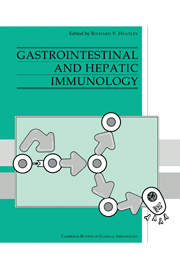Book contents
- Frontmatter
- Contents
- List of contributors
- Preface
- 1 Lymphoid cells and tissues of the gastrointestinal tract
- 2 Lymphocyte migration to the gut mucosa
- 3 Regulating factors affecting gut mucosal defence
- 4 Gastritis
- 5 The immunology of coeliac disease
- 6 Inflammatory bowel disease
- 7 Food intolerance and allergy
- 8 Gastrointestinal and liver involvement in primary immunodeficiency
- 9 Secondary immunodeficiency – the acquired immunodeficiency syndrome (AIDS)
- 10 Intestinal infections
- 11 Lymphomas
- 12 Small bowel transplantation
- 13 Clinical aspects of immunologically mediated intestinal diseases
- 14 Chronic active hepatitis
- 15 Primary biliary cirrhosis
- 16 Immunology and immunopathology of acute viral hepatitis
- 17 Immunology of liver transplantation
- 18 Clinical correlates with hepatic diseases
- Index
1 - Lymphoid cells and tissues of the gastrointestinal tract
Published online by Cambridge University Press: 03 February 2010
- Frontmatter
- Contents
- List of contributors
- Preface
- 1 Lymphoid cells and tissues of the gastrointestinal tract
- 2 Lymphocyte migration to the gut mucosa
- 3 Regulating factors affecting gut mucosal defence
- 4 Gastritis
- 5 The immunology of coeliac disease
- 6 Inflammatory bowel disease
- 7 Food intolerance and allergy
- 8 Gastrointestinal and liver involvement in primary immunodeficiency
- 9 Secondary immunodeficiency – the acquired immunodeficiency syndrome (AIDS)
- 10 Intestinal infections
- 11 Lymphomas
- 12 Small bowel transplantation
- 13 Clinical aspects of immunologically mediated intestinal diseases
- 14 Chronic active hepatitis
- 15 Primary biliary cirrhosis
- 16 Immunology and immunopathology of acute viral hepatitis
- 17 Immunology of liver transplantation
- 18 Clinical correlates with hepatic diseases
- Index
Summary
Introduction
Mucosal immunology is of relevance to a large number of different biomedical sub-disciplines, as well as being of intrinsic interest for the study of the basic biology of the system. For efficiency, and a directed response, potential vaccines to enteric pathogens should be delivered by the oral route and generate specific mucosal immunity. Oral vaccination is also the preferred route to generate systemic immunity. In the developed world, the idiopathic inflammatory bowel disease and food-sensitive enteropathies are relatively common diseases, both of which have an immunological basis, and despite intense research in recent years, are still poorly understood.
It is still not widely appreciated that the gut-associated lymphoid tissue is the largest in the body. There is more organised lymphoid tissue in the gut than the rest of the body and there are more T cells in the gut epithelium than in the spleen. Furthermore, some cell types such as IgA2 secreting plasma cells and T cells using the gamma-delta T cell receptor are abundant in the gut, but less common elsewhere. It is the purpose of this chapter to detail the lymphoid tissues and cell types present in the gut, to delineate their unique features, and to briefly discuss how these cells interact with gut-derived antigen.
Peyer's patches
The organised lymphoid tissue of the small intestine was first described by de Peyer in 1667. Structurally, Peyer's patches are organised areas of lymphoid tissue in the mucosa overlying the muscularis mucosa.
- Type
- Chapter
- Information
- Gastrointestinal and Hepatic Immunology , pp. 1 - 23Publisher: Cambridge University PressPrint publication year: 1994
- 3
- Cited by



